Passive Income Strategies For Web Designers
Finding ways to earn passive income is a growing concern among many freelance designers. I’ve always loved client work, but I have to admit that the pressure of juggling multiple bosses and constant deadlines eventually started to wear me down.
As a result, in the past couple of years I’ve been focusing more and more on personal projects, and thinking about ways to make money from them. I’ve sold themes and templates and written an eBook, and I’m now focusing on launching my own job board for designers.
In a previous article for Smashing Magazine, I compared various ways to sell software products online. What I’ll do in this article is not just compare ways in which freelance designers can earn passive income, but speak about my own experience in exploring these avenues.
And, yes, that will include telling you how much money I’ve made!
Disclaimer: This post is about my own personal experience. Just because I have, for example, never made much money from ads does not mean you can’t. So, please take this as a “Here’s what I did,” not as a “Here’s what you should do.”
Themes
I was lucky enough to join ThemeForest (the biggest themes and template marketplace on the Web) in January 2009, shortly after it launched. ThemeForest seemed like the perfect way for an unknown, inexperienced designer to make money: no need for a fancy degree or years of experience — just design something cool and the market will reward you. In fact, that’s exactly what happened. Top designers now gross six-figure annual incomes solely from selling themes, and some do so despite being relative unknowns in the rest of the design world.
So, what was the result of my own venture into theme-making?
Overall, it was very positive. First, it helped me launch my design career, because my first couple of freelance clients were all people who contacted me after seeing my templates. It was also lucrative: in June 2010, my best month ever, I made $1,248. For a year after that, having not even launched new themes, my existing ones still made me around $200 a month, with minimal effort on my part.
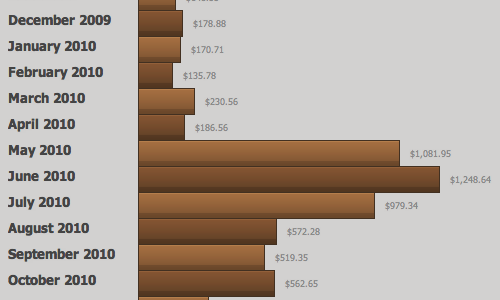
Altogether, I’ve earned around $12,675 from ThemeForest in two and a half years; nothing to scoff at, especially because I completely stopped supporting my themes about a year ago. So, if selling themes is so great, why did I design the last one more than two years ago? There are a couple reasons for this, the main one being that the market drastically changed, and customer expectations changed with it.
Designing a good-looking theme isn’t enough anymore. If you want your theme to be competitive, you need to support shortcodes, build a custom back end and design multiple layouts, not to mention provide excellent support and build a documentation website.
In other words, in the span of a couple years, building themes went from something that you could do on the side to being a full-time job. Because I didn’t want to become a WordPress guru and spend all of my time creating themes, I decided to put theme design aside.

Theme design, then, is one of the best ways a designer can earn passive income, but it’s also one of the hardest. By the way, another important factor to consider is that theme design makes sense only if you’re in it for the long run and can reinvest the time you spend on a theme into subsequent ones (by reusing bits of code, streamlining the process, building a mailing list, etc.).
Pros:
- Very lucrative if you’re successful.
- No need for experience or education, as long as you have the right skills.
- No need to be famous or have a big following.
Cons:
- Requires a lot of HTML and CSS coding, and probably familiarity with WordPress or another CMS.
- Providing good support is time-consuming.
- You will probably need to launch more than one theme before the venture becomes more profitable than regular freelance work.
Icons And Vectors
*Note: I have never released any icon packs, brushes or vector resources, so I asked Vincent Le Moign of Webalys for his thoughts on this market.*
“I started to create passive income by accident. In 10 years of freelancing, I’ve created a small stock of vector graphic elements that I’ve been using repeatedly for interface design. At first, it was just a few Illustrator files, where I pasted GUI elements, such as buttons and icons, to reuse in future projects.
“In June 2010, I decided to make it comprehensive and consistent, and then release it for free. Inspired by Web application frameworks such as Ruby on Rails, the User Interface Design Framework was based on the concept of modularity, productivity and fast wireframing.”

“It took me a few weeks to create it, without making any money on it, but the feedback was impressive: in two months, 52 000 unique visitors, more than 1000 tweets, dozen of blog posts. Even the godfather of Web design, Jeffrey Zeldman, reviewed it. I was high on a cloud!
“Looking at it now, I have no idea why I invested so much time doing it — probably because of passion, and I felt the urge to fill a gap: this kind of tool was missing. I didn’t make any conscious plan, but this is how my new career started. Seeing this steady traffic, I thought I could build a premium version on top of it. A few month later, I launched a commercial pack filled with 750 vector icons. Then the magic happened.”

“Money started to add up in my PayPal account. I remember checking my inbox compulsively to see if the latest emails announced sales. It wasn’t a lot of sales yet, just a few hundreds dollars, but it showed me the way: that making a living from passive income was possible. In the past two years, the sales gradually went up and reached the point where I could stop working for customers and spend 100% of my time on my own products. In 2011, I launched one more resource: a vintage vector ornaments pack, which was successful, too. Having two different products guaranteed a more regular income flow.
“I currently earn a few thousands dollars each month from sales. My income is the same as what it was when I was a freelancer, but I have the satisfaction of developing my own products. But designing quality content is not enough to make sales. I actually spend most of my time on other tasks:
- Creating the sales pages, writing the text, polishing the product websites.
- Setting up the e-commerce solution. In two years I’ve wasted a lot of time building the sales process. I switched e-commerce solutions four times until I found the perfect one (DPD — almost unknown but highly recommended).
- Advertising and promoting. I spent a lot of time and money finding the best sources of traffic.
- Improving marketing and SEO, and setting up and learning how to use products such as MailChimp, Google Analytics, GetClicky, SEOmoz, Curebit.
- Optimizing the conversion rate by setting up A/B tests with Google Optimizer.
- To be honest, I don’t provide a lot of support (a few minutes a day), but I commit to responding as soon as possible. And I spent a lot of time writing the documentation (with screenshots) to avoid answering the same questions over and over again.
“So if you’re considering creating premium resources, the answer is yes, you can live off of it. But your creativity and designs skills are not the keys elements of success. You’ll need to invest a lot of time in learning and practicing all areas of business: marketing, promotion, copywriting, SEO, analytics, etc.
“Actually, this is the beauty of launching your own products: you will become a better designer not by creating better graphics, but because you will have a full view of the business and will master a full range of skills. You will see your customer with new eyes and focus on the efficiency of your designs more than their outer beauty. And believe me, your customer will love that and will pay you more if you increase their sales.
“On the downside, the market is becoming highly competitive. The same shift that is taking place with templates is happening in my market. Competition is becoming fierce, and not a week goes by without a few more icon packs getting released. I mean, which designer hasn’t launched their own set by now?
“I’ve counted more than 50 competitors who sell icons, and the number and quality is improving constantly.”
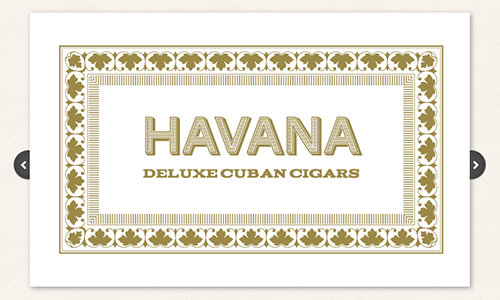
“Also, the growing trend of discounted bundles (like on Dealotto and MightyDeals), where you get a ton of resources for a few bucks, risks drying up the market. I’m still not sure if this will convince more designers to add these resources in their workflow, thus expanding the market, or stop them from buying these packs at the current prices.
“This tougher competition has forced me to spend months this year doubling the number of my icons, from 750 to 1500, and adding variations for different software, such as PowerPoint and Keynote. Also, I’ve improved my other product, the vector ornaments, and paid another freelancer to fix a few problems. And I recently paid a great calligrapher to create a logo for Vectorian and improve the branding. Expenses and time investment are going up.
“Another problem: I don’t think my designs are as creative or as good as before. I’m so focused on creating the content, marketing it and thinking like a business owner that I sometimes have less passion for design and less creativity.” Pros:
- You already have the skills to create the content.
- If you use marketplaces such as iStockphoto and GraphicRiver, you don’t need to build a website or promote your products.
- Almost no support is required (if you write good documentation).
- You will expand your skills and become more business-oriented.
- You don’t need to write in English (this was a big advantage for me because I’m French and a poor English writer).
Cons:
- It’s time-consuming.
- The expectations of quality and quantity are rising. And more and more free content is becoming available.
- The market is competitive; you need not only great content, but great marketing.
Advertising
I can still remember when Carbon first accepted one of my websites into its advertising network. I was overjoyed! At last, I would be able to dip into the river of money that flows into Internet advertising! Of course, I didn’t expect to earn a salary from ads alone, but I thought it might be a nice supplement — say, a couple of hundred dollars a month.
If you’ve ever run any kind of ads on a website, you know what’s coming: my first payment must’ve been for something like $5. So, yes, Internet ads are no fun — unless you bring in a massive amount of traffic (or if you plaster your website with a massive number of ads).
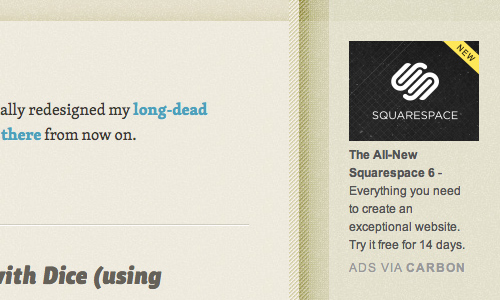
Since then, I’ve joined Fusion Ads for my blog and joined Yoggrt for The Toolbox (both ad networks belong to BuySellAds). To give you some numbers, The Toolbox gets about 20,000 uniques a month, which is not huge but still decent. This converts to $30 to 60 per month. My blog is a little more successful (probably due to the higher click-through rate), and I’ve succeeded in pulling in $100 or $200 in extremely good months when a couple of my posts went viral. But the average has been around $50 to $100.
Altogether, the total from advertising comes in at around $600 over six months. So, as far as I’m concerned, ads are a good way to pay for a meal to celebrate the weekend, but not much more unless you decide to become a full-time blogger.
Pros:
- Does not require any work.
- Joining a respected ad network will give your website cachet.
Cons:
- Pays for a meal, if you’re lucky.
- Did I mention that you probably won’t earn anything?
Books
Writing an eBook (or plain old book) might seem relatively easy. After all, we all know how to write, right? In fact, I’d say that actually writing the book is not the hardest part. Sure, developing a good writing style takes years of practice, but the truth is that people will forgive clumsy writing if you have something valuable to say. No, the real work in writing eBooks is in what comes before and after the writing.
Before writing the first word, you need to come up with a good topic and, more importantly, develop the skills necessary to make you an authority on the topic. Simply compiling existing knowledge might work for a blog post, but it won’t fly when you ask people to hand out their hard-earned cash.
Consider writing an eBook only if you have a couple of years of experience under your belt and feel ready to distill it into a book. And please don’t make the mistake of thinking it’s over once you’re done writing. That’s actually when the real battle begins: selling your book.
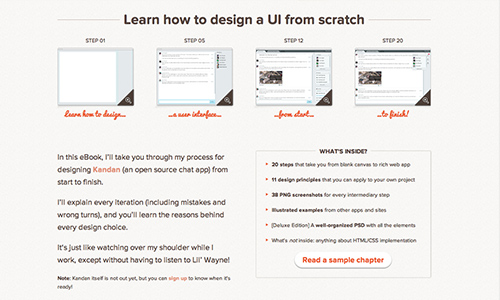
How will people find out about your book? What reason will they have to buy it? Why should they buy yours instead of competing books? These are the kinds of questions you’ll have to face.
If you want to rest your chances on a personal website, take a page from Jarrod Drysdale’s book (pun intended), Bootstrapping Design. Drysdale not only set up a website for his book, but also used a mailing list before and after the launch to promote it by sending out sample chapters and asking his audience various questions. I did my best to promote my eBook by setting up a landing page, writing guest posts about it and holding giveaways.
Another good strategy is to target a niche. This is what I did by focusing specifically on user interface design for startups, and Matthew Butterick also did it with his Typography for Lawyers book.
Last but not least, I strongly recommend partnering up with websites such as AppSumo and Hyperink to open up distributions channels for your book and to create new revenue streams.

Writing an eBook turned out to be great for me. I had a great launch, making about $8,000 in the first two weeks alone. Since then, sales have slowed considerably, but I did manage to make another $6,000 in the four months since the launch. In my case, the key to earning more was partnering up with AppSumo and Dealotto, which both brought in a couple of thousand dollars in extra revenue after the initial boost from the launch faded away.
Pros:
- Almost no support needed.
- No technical skills required.
Cons:
- You need to have something to say.
- A lot of promotion is required.
- The market is competitive and crowded.
- Sales will quickly dry out after launch.
Software As A Service
Building a business requires a ton of work and commitment, but unlike freelance design or, say, mowing lawns, building a software-based service of some kind takes away the 1:1 relationship between your efforts and your income. Some services charge only once, as is the case with job boards such as Authentic Jobs and my own Folyo. But, of course, the cash cow of passive income is subscription services because they enable you to anticipate your cash flow and build a steady income stream.
The obvious challenge in building a software service is that it requires technical skill, which you might not have if you’ve got a design background. It’s not the end of the world, though. You could find a cofounder, outsource the project or even learn the skills yourself. And you don’t need to go all out right away. When I speak with non-technical founders, I often notice that a preliminary version of their idea could very well have been achieved with a simple WordPress blog.
If you explore a little deeper, you’ll realize that opportunities for monetization are everywhere. For example, WordPress has numerous membership subscription plugins. Even MailChimp lets you charge for newsletter subscriptions. By thinking outside the box and combining existing services, even a moderately technical person can get a minimum viable product out the door.
I launched Folyo (a website that helps startups find great, vetted freelance designers) about a year ago:
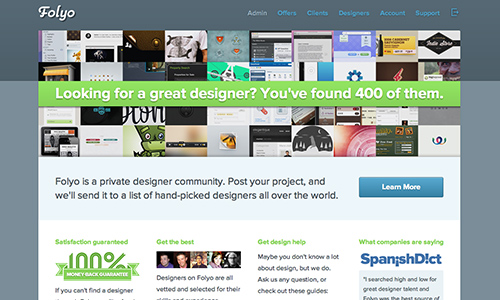
For the first couple months, I ran it as a simple newsletter of job offers, with a Wufoo form for submitting projects. There was no back end, no database and no user accounts! This was enough to validate the concept and to motivate me to build a real app. So, I found a Ruby on Rails developer through a Hacker News jobs thread and paid him about $3,000 to create a working app (a process I cover in more detail on my blog).
Meanwhile, I had been learning Ruby on Rails myself, so I’ve since taken on part of the development myself, outsourcing the remainder to a friend in exchange for some design work. Was it worth it? While I have no doubt I would be earning more if I was focusing on freelance work rather than Folyo, I’m still very happy that I decided to launch my own project.
I currently make about $1,000 a month from Folyo, which is good enough for one person with minimal costs after one year. More importantly, each day spent working on Folyo makes it a little better and increases the website’s value (unlike with client work, where working on one project doesn’t help you with the next).
Of course, when I’m working on Folyo, I do very little actual designing. In fact, my time breaks down something like this:
- Email and support: 20%
- Blogging: 20%
- Coding: 40%
- Miscellaneous tasks: 10%
- Design: 10%
So, if you’re thinking of launching your own service, consider that it probably means spending much less time designing.
Pros:
- Theoretically, it can be lucrative and even get you bought out by Google or Facebook.
- The work is very motivating.
- You have the freedom to build anything you want.
Cons:
- You will need to step way outside of your comfort zone.
- The chance of failure is high.
- At the end of the day, relatively little designing is involved.
Lessons Learned
What did I learn from all this? And what would I do differently if I could start over? Well, one thing I realized is the importance of building a network. You need to find a way to get connected, whether it’s by becoming a famous designer, writing a blog, building a Twitter following or, ideally, doing all that and more.
Of course, a lot of great designers focus simply on doing a great job and don’t concern themselves too much with the rest. But maybe these designers went to a great art school and kept in touch with their classmates. Or maybe they attend design meetups regularly. One way or another, you can bet that most successful designers maintain a network, even if they don’t realize it.
Blogs and Twitter are simply the digital equivalent of this. Making it entirely on your own is very hard, so the earlier you start cultivating these relationships, the better.
Related to this, have a strong identity. Try to stand out from the crowd, and make sure people know who you are. You can achieve this by cultivating your own style, being involved in high-profile or viral projects or, what I think is the best way, launching your own projects.
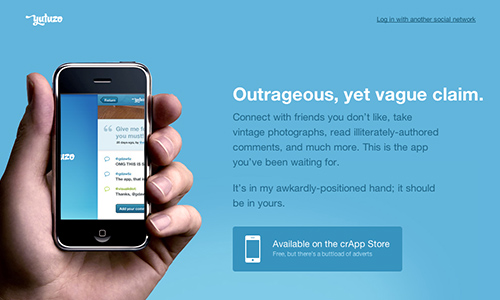
If you want to see how it’s done, look no further than Visual Idiot, who converted his great design skills and weird sense of humor into a job at GoSquared, despite no one on the Internet even knowing his real name.
This may sound obvious, but the reality is that projects that help build your network or identity are not often the most lucrative ones (actually, they usually don’t make you any money). So, it’s tempting to take that high-paying contract to design a pharmaceutical company’s intranet, rather than spend a couple days building a silly JavaScript that replaces stuff with pictures of cats.
But guess what? Nobody outside of Big Pharma will ever see that intranet’s beautifully crafted pixels, but that cat website might go viral and lead to thousands of people suddenly becoming aware of your existence.
To summarize, the main lesson I’ve learned over the last couple of years is to have a long-term view and invest in yourself, not chase a quick buck.
The plan is rather simple, then: build a network, cultivate a strong identity to ensure the network knows who you are, and then come up with a product you can market to it.
Of course, each step usually takes a couple years. I said it was simple; I didn’t say it was easy!
Further Reading
- How To Guarantee Your Income With Agile Billing
- Free Website ROI Calculator (Google Spreadsheet)
- How To Profit From Selling Digital Products
- Getting Started with Banner Advertisements


 Flexible CMS. Headless & API 1st
Flexible CMS. Headless & API 1st


 Register!
Register!


